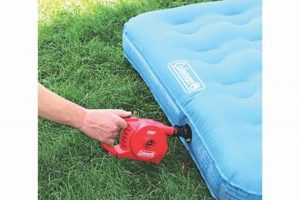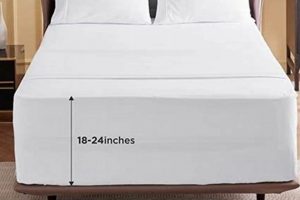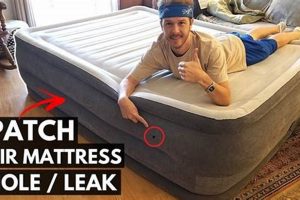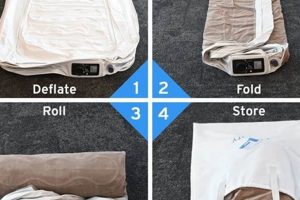Addressing punctures in inflatable sleeping surfaces ensures continued usability and comfort. Such damage commonly results in gradual air loss, diminishing the support and elevation initially provided. Identifying and repairing these breaches are essential to restoring the integrity of the mattress. For instance, a slow deflation during the night signifies a probable breach that requires attention.
The prompt repair of these inflatable structures contributes to economic savings by extending the product’s lifespan, preventing the need for premature replacement. Furthermore, maintaining the air retention capabilities prevents discomfort and potential sleep disruption, particularly during camping or when serving as a temporary bed for guests. Historically, patching techniques have evolved from simple adhesives to more sophisticated bonding agents, reflecting a growing emphasis on durability and long-term performance.
The ensuing discussion will detail methods for locating punctures, preparing the surface for repair, selecting appropriate patching materials, and executing the repair procedure. Focus will also be given to preventive measures to minimize the likelihood of future damage, and alternatives for mattresses where patches are unfeasible.
Effective Strategies for Repairing Inflatable Mattress Damage
The following guidance is designed to facilitate the successful remediation of air loss issues in inflatable mattresses, ensuring their continued serviceability and comfort.
Tip 1: Conduct a Thorough Inspection. Before initiating any repair, meticulously examine the mattress surface. Submerge sections in water to identify escaping air bubbles, marking the precise location of each breach with a permanent marker.
Tip 2: Clean the Affected Area. Use isopropyl alcohol to thoroughly cleanse the area surrounding the puncture. This removes oils and debris, promoting a stronger adhesive bond between the mattress and the patching material.
Tip 3: Employ Appropriate Patching Materials. Utilize a vinyl repair kit specifically designed for inflatable products. Avoid using general-purpose adhesives or tapes, which may lack the necessary flexibility and adhesive strength for long-term repairs.
Tip 4: Apply Even Pressure During Adhesion. After applying the patch, use a smooth, hard object, such as a roller or the back of a spoon, to exert consistent pressure across the entire surface of the patch. This ensures uniform contact and minimizes air pockets.
Tip 5: Allow Adequate Curing Time. Adhere strictly to the adhesive manufacturer’s recommended curing time before re-inflating the mattress. Premature inflation can compromise the bond and lead to patch failure.
Tip 6: Reinforce Larger Tears. For punctures exceeding a quarter-inch in diameter, consider using multiple layers of patching material or incorporating a fabric backing for added structural support.
Tip 7: Preventative Measures are Crucial. Position the mattress on a smooth, debris-free surface. Using a mattress protector can significantly reduce the risk of punctures from sharp objects.
By meticulously executing these strategies, users can effectively restore the airtight integrity of their inflatable mattresses, extending their lifespan and preventing further inconvenience.
The subsequent sections will address long-term maintenance and alternative solutions should repair prove unfeasible.
1. Locate the Puncture
Accurately pinpointing the source of air leakage is the foundational step in effectively addressing an inflatable mattress malfunction. Without identifying the precise location of the breach, any subsequent repair efforts are rendered speculative and likely ineffective, hindering the process of successfully fixing the mattress.
- Auditory Detection
Auditory detection involves listening closely for hissing sounds emanating from the inflated mattress. This method is most effective in quiet environments and can often guide the user to the general area of the leak. For example, slowly moving the ear along the mattress surface may reveal a faint but distinct hissing sound, indicating escaping air. Its effectiveness, however, is limited to larger punctures or areas with significant air loss.
- Soapy Water Application
The application of soapy water provides a visual indicator of air escaping from a puncture. By gently applying a thin layer of soapy water to the mattress surface, escaping air will form visible bubbles at the point of the leak. This technique is particularly useful for identifying smaller, more difficult-to-detect breaches. For instance, a slow leak may only produce a small, slowly expanding bubble, requiring careful observation. This method allows for precise identification, maximizing the efficiency of subsequent repairs.
- Tactile Examination
Tactile examination involves manually inspecting the surface of the mattress for irregularities, such as small cuts, abrasions, or weak spots. Running a hand along the surface, particularly in areas suspected of damage, can reveal subtle textures or depressions that indicate a potential puncture. A rough patch or a slight indentation might signify a compromised area. This method is beneficial for detecting punctures caused by physical damage but may be less effective for identifying pinhole leaks.
- Immersion Testing
Immersion testing involves submerging sections of the inflated mattress in water to observe for escaping air bubbles. This is particularly effective for locating multiple or extremely small punctures. Submerging the mattress section by section and watching for streams of bubbles emerging from the surface allows for precise leak identification. This method is suitable for mattresses that can be safely submerged without causing further damage and is often considered the most reliable way to locate all punctures.
Each of these puncture location techniques contributes to the overall efficacy of restoring an inflatable mattress to its intended functionality. Accurate identification of the leaks origin is essential to minimize repair time and ensure long-lasting results, ultimately mitigating further air loss.
2. Surface Preparation
Effective surface preparation is paramount to achieving a durable and lasting repair of inflatable mattresses. It directly influences the adhesive bond between the patching material and the mattress surface, thereby determining the long-term success of the repair.
- Cleaning and Degreasing
Contaminants such as oils, dirt, and residue impede the adhesion process. Thorough cleaning with a suitable solvent, such as isopropyl alcohol, removes these impediments, creating a clean substrate for bonding. For instance, if a mattress has be
en used outdoors, it likely harbors microscopic debris that must be eliminated to ensure patch integrity. The absence of proper degreasing leads to premature patch failure. - Abrasive Texturing
Light abrasion of the area surrounding the puncture introduces microscopic surface irregularities, increasing the available surface area for adhesive bonding. This can be achieved using fine-grit sandpaper or a specialized abrasion pad. An example is lightly sanding the vinyl around the leak to create a slightly rougher surface. This mechanical preparation amplifies the adhesive’s grip on the material, resulting in a stronger, more reliable seal.
- Drying and Ventilation
Moisture interferes with adhesive curing and weakens the bond strength. Allowing the prepared surface to air dry completely after cleaning is critical. Adequate ventilation promotes faster evaporation of residual solvents. If the cleaned area is damp, the adhesive will not properly adhere, potentially leading to patch lifting or air leakage. Ensuring a completely dry surface is imperative for optimal adhesion.
- Appropriate Working Environment
The surrounding environment during surface preparation significantly impacts the outcome. Dust, excessive humidity, or extreme temperatures can compromise the adhesion process. A clean, dry, and moderately temperate environment facilitates optimal surface preparation and adhesive application. Performing the repair in a garage or controlled indoor setting minimizes environmental interference, leading to a more successful repair.
These facets of surface preparation, when executed meticulously, contribute significantly to the efficacy of the repair effort. Neglecting any of these aspects undermines the adhesive bond and increases the likelihood of future air leakage, thereby reducing the lifespan of the repaired mattress. The integration of these steps is crucial for effectively fixing an air mattress leak.
3. Appropriate Patching
The selection and application of suitable patching materials represent a critical juncture in efforts to address and ultimately fix an air mattress leak. The causal relationship between choosing an inadequate patch and subsequent repair failure is direct and demonstrable. If the patching material lacks the necessary flexibility, tensile strength, or adhesive properties, it will not effectively seal the puncture, leading to continued air loss and rendering the repair ineffectual. For example, using household tape instead of a vinyl repair patch will almost certainly result in a temporary and inadequate seal, failing to address the underlying issue of the leak.
The importance of appropriate patching as a component of successfully restoring an air mattress cannot be overstated. It directly affects the longevity and reliability of the repair. The patching material must be compatible with the mattress material, typically vinyl or PVC, to ensure a strong and durable bond. Furthermore, the size and shape of the patch should adequately cover the puncture and distribute stress evenly to prevent future tearing. Real-life examples include utilizing a larger, circular patch for tears or cuts, which helps to reduce stress concentrations around the edges compared to smaller, square patches. Neglecting these considerations often leads to repeated repairs or the ultimate disposal of the mattress.
In summary, the concept of appropriate patching embodies the crucial connection between material selection, application technique, and the overall effectiveness of addressing inflatable mattress damage. The practical significance lies in prolonging the lifespan of the product, preventing unnecessary waste, and ensuring a comfortable and reliable sleeping surface. Choosing the right patch and applying it correctly are essential for achieving a durable seal and ultimately fixing an air mattress leak, mitigating the need for costly replacements.
4. Adhesive Selection
The selection of an appropriate adhesive is critical to the process of repairing inflatable mattresses. The efficacy of the adhesive directly dictates the bond strength between the patch and the mattress material, consequently influencing the longevity of the repair. Using an unsuitable adhesive invariably leads to premature patch failure and continued air leakage. For example, cyanoacrylate adhesives (super glue), while providing rapid bonding, typically lack the flexibility and water resistance required for inflatable mattress repairs, rendering them unsuitable for a durable fix. The improper selection of an adhesive directly undermines efforts to restore the mattress’s functionality.
The specific characteristics of the adhesive must align with the material composition of the mattress, typically vinyl or PVC. Adhesives designed for flexible plastics exhibit superior adhesion and resistance to tearing under stress. Furthermore, water resistance is a crucial attribute, especially for mattresses used in camping or outdoor environments. A relevant example involves specialized vinyl repair adhesives that create a chemical bond with the mattress material, offering a significantly stronger and more durable seal compared to general-purpose adhesives. Adhesives formulated for marine environments, known for their high water resistance, exemplify choices where humidity and moisture are present. The long-term performance of a patch is directly related to its adhesive, it is a crucial factor.
Therefore, the adhesive selection is not merely a supplemental step but an integral element. The success hinges on understanding the composition of the mattress and the operating conditions under which it will be used. By choosing an adhesive formulated for flexible plastics, emphasizing water resistance, and ensuring proper application, the likelihood of achieving a durable and effective seal is substantially increased. Failure to consider these criteria inevitably leads to patch failure and further leakage, necessitating repeated repairs or complete replacement of the mattress.
5. Application Technique
The method by which a repair patch is applied directly affects the success of efforts to fix an air mattress leak. The effectiveness of the adhesive bond is highly sensitive to the technique employed, impacting the long-term integrity of the repair. Inadequate pressure, improper patch placement, or the introduction of air pockets can compromise the seal, leading to premature failure and continued air loss. A meticulously chosen patch and adhesive are rendered ineffective if the application technique is flawed. For instance, rapidly applying a patch without first ensuring proper alignment and uniform pressure will likely result in an incomplete seal, necessitating a repeated repair.
Proper application technique encompasses several key elements. The patch should be precisely aligned over the puncture, ensuring complete coverage with an adequate margin around the damaged area. Consistent, even pressure must be applied across the entire surface of the patch to facilitate optimal adhesive contact. A roller or smooth, hard object can be utilized to eliminate air pockets and ensure uniform bonding. A real-world example includes the use of a seam rolle
r, typically employed in wallpapering, to apply consistent pressure and eliminate air bubbles during patch application. This attention to detail significantly enhances the strength and durability of the repair. Moreover, working in a clean, dust-free environment minimizes the introduction of contaminants that could weaken the bond.
In summary, the application technique is an indispensable component of a successful repair. Consistent pressure, precise alignment, and a clean working environment are critical factors. Neglecting these considerations invariably leads to a compromised seal and recurring air leakage, negating the benefits of quality patching materials and adhesives. Mastery of the application process is therefore essential to effectively restore an air mattress to its intended functionality, prolonging its lifespan and mitigating the need for costly replacements.
6. Curing Time
Curing time, defined as the period required for an adhesive to achieve its optimal bond strength, is a critical factor in any attempt to rectify air leakage. Insufficient curing undermines the adhesive bond between the patch and the mattress, resulting in compromised repairs. The correlation between inadequate curing time and subsequent repair failure is direct. Premature inflation or use of the mattress before the adhesive has fully set subjects the bond to undue stress, potentially leading to patch detachment or renewed air leakage. This highlights the significance of adhering to manufacturer-specified curing times for the chosen adhesive to ensure adequate bond strength and longevity of the repair. For example, vinyl repair adhesives often require 24-72 hours to reach full strength, and ignoring this recommendation can lead to immediate repair failure upon inflation.
The duration of the curing process is influenced by several variables, including ambient temperature, humidity, and the specific chemical composition of the adhesive. Elevated temperatures generally accelerate curing, while low temperatures can significantly retard the process. High humidity can also interfere with the curing of certain adhesives, weakening the bond. Consequently, the curing process should ideally take place in a controlled environment, adhering to the adhesive manufacturer’s guidelines. In practical applications, a repaired mattress should be left undisturbed in a well-ventilated area, away from direct sunlight or extreme temperatures, for the recommended curing duration. This cautious approach ensures that the adhesive achieves its maximum potential bond strength, reinforcing the integrity of the repair.
In summary, curing time is not a supplementary step, but an integral element in effectively repairing air mattress damage. It directly impacts the adhesive bond’s strength and durability. Failure to adhere to recommended curing periods compromises the repair, leading to recurrent air leakage. By understanding the influence of environmental variables and adhering to manufacturer guidelines, the success rate of these repairs is significantly increased, thereby extending the lifespan of the air mattress and mitigating the need for premature replacement.
7. Prevent Future Leaks
Mitigating the potential for future punctures and abrasions is integral to prolonging the operational lifespan of inflatable mattresses and reducing the necessity to enact procedures to fix an air mattress leak. These preventative measures address underlying causes of damage, minimizing the frequency of required repairs.
- Proper Storage Techniques
Correct storage methods significantly reduce the likelihood of physical damage. Deflating the mattress fully, folding it neatly, and storing it in a protective bag or container shields it from sharp objects, abrasive surfaces, and extreme temperatures. For instance, storing a deflated mattress under heavy items in a garage can lead to punctures or weakened material, whereas storing it in a climate-controlled environment in its original packaging offers optimal protection. Implementing appropriate storage strategies minimizes exposure to damaging elements, thereby decreasing the frequency of leaks.
- Surface Preparation Before Inflation
Prior to each inflation, a thorough inspection of the intended surface area is crucial. Removing sharp objects, such as small rocks, thorns, or debris, prevents punctures from beneath. Placing a protective barrier, such as a tarp or thick blanket, between the mattress and the ground adds an additional layer of defense. Failure to prepare the surface adequately increases the risk of immediate damage upon inflation. One example is clearing a campsite of twigs and stones before setting up an inflatable mattress, directly reducing puncture risks.
- Optimal Inflation Levels
Maintaining correct inflation levels, as specified by the manufacturer, prevents over-stressing the mattress material. Over-inflation can weaken seams and increase vulnerability to punctures, while under-inflation can cause the mattress to bottom out and become susceptible to damage from underlying surfaces. Utilizing a pressure gauge ensures that the mattress is inflated to the recommended pressure, optimizing its structural integrity and resistance to punctures. Consistent adherence to inflation guidelines contributes to the longevity of the mattress and diminishes the need to address leakage.
- Regular Inspection and Maintenance
Periodic examination of the mattress surface allows for early detection of potential issues. Identifying and addressing minor abrasions or weak spots before they develop into full-scale punctures can prevent significant air loss. Cleaning the mattress regularly with mild soap and water removes dirt and debris that could contribute to material degradation. For example, noticing a small scuff on the mattress surface and applying a protective coating can prevent it from evolving into a puncture. Proactive inspection and maintenance preserve the integrity of the mattress and reduce the frequency of needed repairs.
These multifaceted preventative strategies represent a comprehensive approach to minimizing damage to inflatable mattresses. By integrating proper storage, surface preparation, controlled inflation, and routine maintenance, users can significantly reduce the likelihood of needing to fix an air mattress leak, thereby extending the useful life of the product and reducing repair costs.
Frequently Asked Questions
The following addresses common queries regarding the diagnosis and repair of air leakage in inflatable mattresses, offering insight into practical solutions and preventive strategies.
Question 1: What is the most effective method for locating a small puncture in an air mattress?
Submerging sections of the inflated mattress in water allows for the identification of escaping air bubbles, pinpointing even minute punctures. Alternatively, applying soapy water to the surface can reveal leaks through bubble formation.
Question 2: Is it possible to repair a leak near a seam, and does the approach differ?
Repairing a seam leak presents challenges due to the inherent stress concentration in that area. A larger patch that extends beyond the immediate vicinity of the seam, coupled with a flexible adhesive, is recommended to distribute the stress effectively.
Question 3: What types of adhesives are best s
uited for air mattress repairs?
Adhesives specifically formulated for vinyl or flexible plastics offer superior bonding and durability for air mattress repairs. Cyanoacrylate adhesives (super glues) are generally unsuitable due to their lack of flexibility.
Question 4: How long should the adhesive cure before the air mattress is reinflated and used?
Adherence to the adhesive manufacturer’s specified curing time is critical. Premature inflation can compromise the bond and lead to patch failure. Curing times typically range from 24 to 72 hours, depending on the adhesive.
Question 5: Are there any preventative measures to minimize the risk of future leaks?
Positioning the mattress on a smooth, debris-free surface, utilizing a mattress protector, and avoiding over-inflation are effective preventative measures. Proper storage in a protective bag or container when not in use also helps to mitigate damage.
Question 6: What alternative solutions exist if the puncture is too large or located in an irreparable area?
In instances of extensive damage or irreparable areas, such as valves, professional repair services or complete mattress replacement may be the only viable options.
These FAQs offer succinct guidance on addressing common concerns pertaining to air mattress leakage. By understanding these points, users can effectively maintain and extend the usability of their inflatable mattresses.
The subsequent section will provide a conclusive summary of strategies to fix an air mattress leak, emphasizing key considerations and preventative actions.
Conclusion
The preceding analysis has detailed critical aspects of addressing air leakage in inflatable mattresses. Successful resolution requires meticulous execution across several stages, commencing with accurate puncture localization, proceeding through appropriate surface preparation and patching material selection, and culminating in adherence to prescribed curing times. Preventative measures, encompassing proper storage and usage practices, are equally vital in mitigating the recurrence of such issues.
Effective implementation of these strategies extends the lifespan of inflatable mattresses, minimizing economic burden and environmental impact. Prioritizing preventative measures and diligent repair techniques promotes responsible consumption and sustained functionality. Consistent application of the outlined methods contributes to a prolonged service life, and minimizes the requirement to fix an air mattress leak, thereby supporting both individual economic interests and broader sustainability goals.







